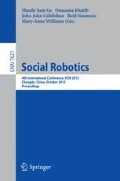Abstract
We used a social robot as a teaching assistant in a class for children’s collaborative learning. The class was designed to be learner-centered, and we formed a class only with a robot and children but without adults. In the class, a group of 6th graders learned together using Lego Mindstorms for seven lessons. Robovie managed the class and explained how to use Lego Mindstorms, then children freely tested their ideas to achieve a given task in each class. In addition, Robovie performed social behaviors, which aimed to build relationships with and encourage the children. Beyond this design, we observed that such social behaviors facilitated interaction among children, which made the class more enjoyable and motivated children to want Robovie around again. In this paper, we report our exploratory analysis about when such social behaviors facilitated interaction among children.
Part of this paper is published in [11] Kanda, T., Shimada, M. and Koizumi, S., 2012, Children learning with a social robot, ACM/IEEE Int. Conf. on Human-Robot Interaction (HRI 2012). This paper newly reports the analysis of facilitation (Section 5).
Access this chapter
Tax calculation will be finalised at checkout
Purchases are for personal use only
Preview
Unable to display preview. Download preview PDF.
References
Burgard, W., Cremers, A.B., Fox, D., Hahnel, D., Lakemeyer, G., Schulz, D., Steiner, W., Thrun, S.: The Interactive Museum Tour-Guide Robot. In: National Conf. on Artificial Intelligence, pp. 11–18 (1998)
Dillenbourg, P.: What do you mean by ’collaborative learning’? In: Collaborative-learning: Cognitive and Computational Approaches, pp. 1–19 (1999)
Han, J., Jo, M., Park, S., Kim, S.: The Educational Use of Home Robots for Children. In: IEEE Int. Workshop on Robot and Human Interactive Communication, pp. 378–383 (2005)
Kanda, T., Hirano, T., Eaton, D., Ishiguro, H.: Interactive Robots as Social Partners and Peer Tutors for Children: A Field Trial. In: Human-Computer Interaction, vol. 19, pp. 61–84 (2004)
Lau, K.W., Tan, H.K., Erwin, B.T., Petrovic, P.: Creative Learning in School with LEGO@ Programmable Robotics Products. In: ASEE/IEEE Frontiers in Educations Conference, pp.12D4/26-12D4/31 (1999)
Miyake, N.: Constructive lnteraction and the Iterative Process of Understanding. Cognitive Science 10, 151–177 (1986)
Mosley, P., Kline, R.: Engaging students: a framework using LEGO robotics to teach problem solving. Information Technology, Learning, and Performance Journal 24, 39–45 (2006)
Saerbeck, M., Schut, T., Bartneck, C., Janse, M.D.: Expressive Robots in Education: Varying the Degree of Social Supportive Behavior of a Robotic Tutor. In: ACM Conference on Human Factors in Computing Systems, pp. 1613–1622 (2010)
Shiomi, M., Kanda, T., Ishiguro, H., Hagita, N.: Interactive Humanoid Robots for a Science Museum. IEEE Intelligent Systems 22, 25–32 (2007)
Slavin, R.E.: Cooperative Learning. Review of Educational Research 50, 315–342 (1980)
Kanda, T., Shimada, M., Koizumi, S.: Children learning with a social robot. In: The 2012 ACM/IEEE International Conference on Human-Robot Interaction, pp. 351–358 (2012)
Author information
Authors and Affiliations
Editor information
Editors and Affiliations
Rights and permissions
Copyright information
© 2012 Springer-Verlag Berlin Heidelberg
About this paper
Cite this paper
Shimada, M., Kanda, T., Koizumi, S. (2012). How Can a Social Robot Facilitate Children’s Collaboration?. In: Ge, S.S., Khatib, O., Cabibihan, JJ., Simmons, R., Williams, MA. (eds) Social Robotics. ICSR 2012. Lecture Notes in Computer Science(), vol 7621. Springer, Berlin, Heidelberg. https://doi.org/10.1007/978-3-642-34103-8_10
Download citation
DOI: https://doi.org/10.1007/978-3-642-34103-8_10
Publisher Name: Springer, Berlin, Heidelberg
Print ISBN: 978-3-642-34102-1
Online ISBN: 978-3-642-34103-8
eBook Packages: Computer ScienceComputer Science (R0)

